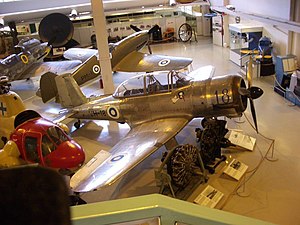Valmet kehitti konetta ankarien taloudellisten rajoitusten puitteissa 1950-luvun alussa VL Pyryn korvaajaksi. Koneen pääsuunnittelijana toimi Martti Vainio. VMT:n lentokoneinsinöörit Lauri Hämäläinen ja T. Mäntysalo tekivät pääosan tämän lentokoneen suunnittelusta vuosina 1948–49. Vaihtoehtojen puutteessa moottoriksi valittiin vanha Bristol Mercury, joita oli sodan jäljiltä varastossa Suomessa.
Prototyypin (VH-1) ensilento tapahtui 6. helmikuuta 1951 Tampereen Härmälän kentältä. Ohjaajana oli tehtaan koelentäjä kapteeni Esko Halme. Onnistuneiden koelentojen jälkeen ilmavoimat tilasi 27. huhtikuuta 1951 30 konetta käsittävän II-sarjan. Vuoden 1954 syksyllä ilmavoimat tilasi vielä 20 koneen ns. III-sarjan. Viimeinen sarjan koneista luovutettiin 15. tammikuuta 1957.
Valmetin Lentokonetehdas valmisti 51 Vihuria kolmessa eri sarjassa (I-III) Kuorevedellä ja Tampereella. Koneiden tunnukset ilmavoimissa olivat VH-1 – VH-51.
Koneesta tuli aikanaan Suomen ilmavoimien eniten käytetty lentokone 1950-luvun puoleen väliin mennessä. Sille tapahtui myös paljon onnettomuuksia, josta lehdistö nosti ison hälyn. Vihurin luotettavuutta puitiin myös eduskunnassa. Toukokuussa 1959 kone joutui lopulliseen lentokieltoon pääministeri Reino Kuuskosken pojan kuoltua Vihuri-onnettomuudessa (14.12.1957 VH-4).
Tämän onnettomuuden jälkeen sattui vielä kaksi, joissa menetettiin ohjaaja: 15.4.1959 Vänr. Sainion ohjaama VH-47 putosi ohjausvirheen takia Kokemäellä ja 20.4.1959 kuoli kok. Mielonen epäonnistuneessa pakkolaskussa Porissa. Kone oli VH-40. Ennen romuttamista Vihureita yritettiin myydä muun muassa Tunisiaan – tuloksetta.
Kirjailija ja Mannerheim-ristin ritari Joppe Karhunen puolestaan sanoo eräässä teoksessaan että kone sinänsä oli jopa erinomainen, mutta sen heikko kohta oli moottori: moottorina käytettiin jo sota-aikana kovilla olleita ja varsin loppuun kulutettuja Bristol Mercury -tähtimoottoreita, joiden rikkoutuminen aiheutti suuren osan onnettomuuksista.
Keski-Suomen ilmailumuseossa on VH-18, joka on ainut säilynyt Vihuri. Sillä lennettiin 802 tuntia, jonka jälkeen se toimi opetusvälineenä Ilmasotakoulussa. Suomen ilmailumuseossa Vantaalla on VH-25-yksilön eturunko, mm. ohjaamoa. Sitä restauroidaan näytteillepantavaksi.
Espoon Kauklahdessa olevan Kuusakoski OY:n tehdashallin kattoikkunat on tehty romutettujen Vihurien takakuomuista.
Tekniset tiedot
Tyyppi: yksimoottorinen ja kaksipaikkainen harjoitushävittäjä
Rakenne: runko hitsattua teräsputkea ja puolikuorirakennetta päällystettynä duralumiinilevyllä, siipi puolikuorirakennetta päällystettynä duralumiinilevyllä.
Kärkiväli: 10,4 m
Pituus: 8,85 m
Korkeus: 3,66 m
Siipipinta-ala: 18,86 m²
Tyhjäpaino: 2 174 kg
Suurin lentoonlähtöpaino: 2 704 kg
Moottori: Bristol Mercury VIII 9-sylinterinen ilmajäähdytteinen tähtimoottori, teho 840 hv (Suomessa lisenssillä valmistettuja, Blenheim ylijäämä-moottoreita toisesta maailmansodasta)
Huippunopeus: 444 km/h 3 600 metrissä
Lakikorkeus: 8 200 m
Nousunopeus: 6 km:iin 12,3 minuuttia
Toiminta-aika: 2,5 h
Lentomatka: 665 km
Aseistus[muokkaa | muokkaa wikitekstiä]
2 kpl 7,7 mm Browning-konekiväärejä, 4 kpl 25 kg pommeja (vain III-sarjassa).
-----------------------------

Valmet Vihuri (Finnish for Gale) was a Finnish advanced two-seat fighter trainer aircraft, serving in the Finnish Air Force between 1953 and 1959. A few airframes have survived, as in the Central Finland Aviation Museum in Finland.
In spite of their economic problems, the aircraft manufacturer Valmet began designing a new aircraft in the beginning of the 1950s, to replace the aging FAF VL Pyrys. Martti Vainio was the chief designer of the project. Most of the planning was made by the aeronautic engineers L. Hämäläinen and T. Mäntysalo in 1948–49. The Bristol Mercury was chosen as the engine, since there were no other alternatives. The Mercury was license made in Finland for the Bristol Blenheim bomber.
Valmet built 51 Vihuri's in three different series (I-III) in Kuorevesi and Tampere. The aircraft had the registration codes VH-1 through VH-51.
Operational use
The Vihuri aircraft became the most-used aircraft in FAF service by the mid-1950s. The aircraft was subject to many accidents, and the press raised a lot of concerns about these. The safety of the Vihuri even became a matter for the government. In May 1959, the aircraft was permanently grounded after the death of the Finnish prime minister's son in the aircraft type. Attempts were made to sell the aircraft to Tunisia, without success.
After the inspection, it became apparent that the type and its design was sound; most of the accidents were due to pilots' often grave flight-regulations violations, and the fact all airframes were well worn by the end of the 1950s. The other problem was the engines. The engines used, Tampella Mercury, were recycled engines of wartime Bristol Blenheim bombers, which were already thoroughly worn out. The planes were sold for scrap to Moser OY. One airframe, VH-18, survives in the Central Finland Aviation Museum, and the fore fuselage of another, VH-25, is being restored. The canopies of the scrapped aircraft remain today as the roof windows of the Kuusakoski metal-recycling plant in Espoo.
Notes
This aircraft is not to be confused with the Finnish fast bomber variant of De Havilland Mosquito, with DB 605 engines, a project which never materialized. In 1943 the FiAF HQ asked VL if it would be possible to build a copy of the Mosquito with DB605 engines. Two crashed British aircraft would have been requested from Germany to serve as models.
The primary attraction was the wooden construction (something that the VL was familiar with). The inquiries indicated that serial production could be started sometime in 1946, as there were other aircraft on queue, and there were difficulties in getting just about everything needed to produce a new aircraft.
The new aircraft was also to be named "Vihuri".
The Central Finland Aviation museum is displaying the VH-18, which is the only preserved Vihuri. It gathered 802 flying hours, after which the aircraft served as an educational machine at the Air Force Academy in Kauhava.





Ei kommentteja:
Lähetä kommentti
Kaikenlaiset kommentit ovat tervetulleita.